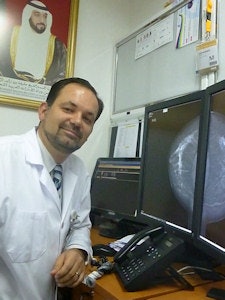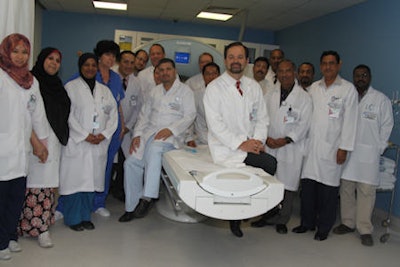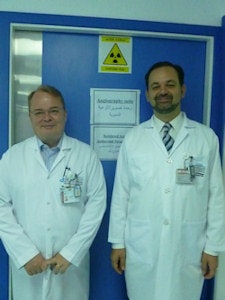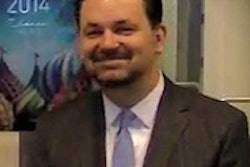
An isolated oasis in the Arabian Desert was an unlikely place for an Austrian radiologist to be offered the most extraordinary opportunity of his career. But as European radiologists worry about job security in the current economic crisis, the story of how Dr. Michael Fuchsjäger and his multinational team have established a state-of-the-art radiology institute shows how the best professional opportunities may lie a long way from home.
In 2009, Fuchsjäger was hired to rebuild, revitalize, and dramatically expand a small and aging radiology unit in the United Arab Emirates. When he arrived, records were kept on cards and images were captured on film and paper. It was, said a colleague, like a museum.
 Dr. Michael Fuchsjäger has built a radiology department from scratch in Abu Dhabi, but soon will return home to Austria.
Dr. Michael Fuchsjäger has built a radiology department from scratch in Abu Dhabi, but soon will return home to Austria."Now we are very close to European standards with our guidelines, policies, and best practices," he commented.
Before oil began to flow in the 1960s, the date palm oasis of Al Ain was a five-day camel trek from Dubai. Today a four-lane highway connects the two cities across the rolling red dunes, but in medical terms Al Ain is still catching up. Fuchsjäger came to a city where many people with serious health issues were sent to hospitals in Europe and the U.S. for treatment. But even health authorities endowed with fabulous oil wealth felt the financial strain -- Emirati families are large and like to travel together.
Al Ain Hospital is owned by the Abu Dhabi Health Services Company, but run by the Austrian hospital management company VAMED and the Medical University of Vienna International, who are increasingly active in the Gulf region. Fuchsjäger has overseen the creation of a fully digital unit, with all the main diagnostic imaging services and techniques, including 64-slice dual source CT, 1.5-tesla MRI, bi-plane angiography, and digital mammography.
Abu Dhabi has made an impressive spending commitment to the people of Al Ain. No figures have been released, but such a comprehensive range of equipment, none of it more than five years old, would cost up to 5 million euros ($6.3 million U.S.). The number of radiology specialists and consultants has increased from four to 11, and Fuchsjäger now manages a team of nearly 70 people from 14 different nations.
"The people here are unbelievably motivated. I really think that the motivation would not be that high in my home country," he said. "It was really great to learn from others -- Egyptians, Indians, Sudanese, etc. -- about their approach to medicine."
Their efforts were recognized in 2010 with Joint Commission International (JCI) accreditation, and this year the Arab Health Congress presented its Excellence in Digital Imaging and Diagnostics award to the unit.
 Fuchsjäger manages a team of nearly 70 people from 14 different nations.
Fuchsjäger manages a team of nearly 70 people from 14 different nations."There's less degeneration here, more infections and trauma cases," remarked consultant radiologist Dr. Jukka Lehtovirta, who sees very different treatment patterns from those in his native Finland.
For example, the average age of a female patient at Al Ain is 29, so hip and knee replacements don't happen often, but diabetes is a serious problem. At least 25% of Emiratis suffer from the disease, the second highest level worldwide, and Al Ain's angiography team deal with a high number of diabetes-related conditions affecting the peripheral vessels.
Expatriate workers commonly require treatment for infectious diseases such as TB, and the almost legendary recklessness of drivers in the region means lots of injuries result from serious traffic accidents. They'd save a lot of money if they wore seatbelts, added Lehtovirta, with a shake of his head.
Radiologists do a five-day week, with one weekend day on-call every month, working across all imaging, although they do not yet offer teleradiology. Life is quiet, but the quality is good in Al Ain.
"It's just so easy. You don't even have to clean your house or iron your shirts!" said Lehtovirta.
 Compared with Europe, many more cases of diabetes and injuries from road traffic accidents are seen by Dr. Jukka Lehtovirta (left) and Fuchsjäger.
Compared with Europe, many more cases of diabetes and injuries from road traffic accidents are seen by Dr. Jukka Lehtovirta (left) and Fuchsjäger.Salaries are untaxed and usually come with an expat package comprising housing, flights home, phone and electricity charges, healthcare, and children's school fees. But there's no pension provision, and Lehtovirta said he earned more overall working back home at a district hospital in Kajaani, Finland. Like many professionals in the Gulf, he's completed two years and is about to leave, joining Helsinki's National Institute of Health and Welfare.
Fuchsjäger makes no pretense that the job here is finished. He says the region's medical services, including his own, still suffer from varying levels of clinical expertise. High staff turnover is a problem, and another is inconsistent financing.
"At the beginning, I had the impression that we had all the money we needed. Now it's changed. The budget has been tightened," he said. "This is not for everyone. As well as your medical skills you need to be sensitive to the different nationalities that you are working with."
It's time too for Fuchsjäger to move on. His wife and young family, with three children younger than 3 years of age, have enjoyed Al Ain's tranquility and safety, but now they are preparing to move back home in July, when he becomes professor and chair of radiology at Graz Medical University. It's a post he was offered, he suspects, partly because he's had experience building a new clinic from scratch -- not something that appears on every radiologist's CV.



















